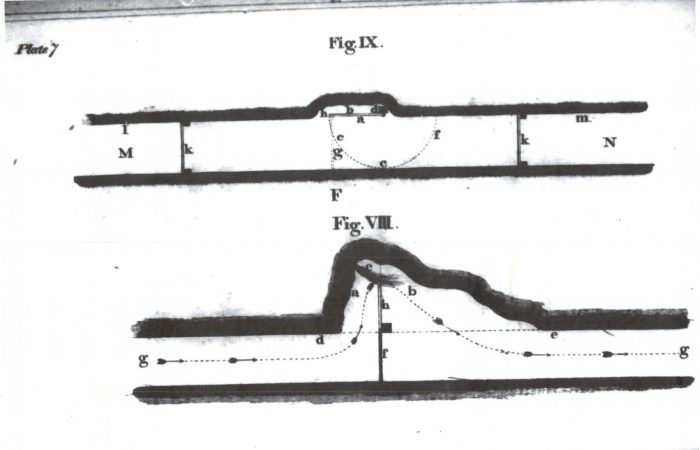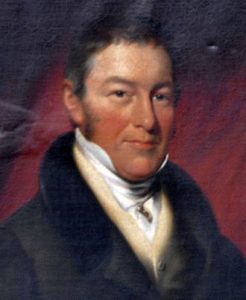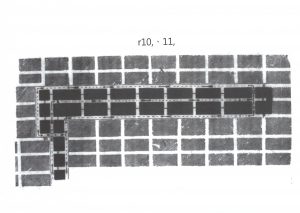
John Buddle 19th Century English Mine Manager seems to know more about ventilating a mine, effects of a methane explosion and making Explosion Resistant Stoppings than 21st Century Mining Engineers
http://www.mineaccidents.com.au/uploads/first-report-of-the-sunderland-society-john-buddle(1).pdf
John Buddle (1773 -1843) was a famous English Mine Manager during the early 18th Century even though up until 12 months ago I had never heard of him.

As part of my crash course of Mining History from Mark Parcell I now do.
He presented a paper in 1815 to the Sunderland Society.
(Following the explosion at Felling Colliery on the 25th of May 1812 where 92 men and boys died, James Wilkinson proposed the formation of a society for the prevention of accidents in coal mines, in the county of Durham. The proposal to form a society was sent on the 1st of September 1813.)
While I do not think much of his attitudes to Coal Mine Workers and their rights, he does seem to understand a fair bit about coal mining, methane and explosions.
I urge all interested to read the full document themselves.
His comments about the steel mills used for artificial lights and the colours of the sparks in explosive quantities of methane are worth the read alone.
The miner would then press a flint against the spinning steel disc producing a stream of sparks which the other miners would work from. As you can imagine, this method supplied the miner with a minimum of light for a lot of effort usually provided by a young boy. Worse than this was that the sparks produced could still ignite methane, as was discovered in 1785 with an explosion at Wallsend Colliery.
I have not copied his comments about using candles for working lights
http://www.mineaccidents.com.au/uploads/first-report-of-the-sunderland-society-john-buddle(1).pdf
In cutting through old workings, only two drifts have been used, as a b, d c. According to this system, the current of air is passed along one drift as a b, and returns by c d. In this case the inflammable air from the old workings X Y, is discharged into the intake drift a b, as well as into the return drift c d ; consequently candles cannot bc used in either.

I have succeeded in rendering the drift a b safely accessible with candles, by driving a third drift e f. In this ease, we have a centre drift a b for the intake of the air, and two flank c d and e f for its return.
In practice, it is always found that the current of air, passing along the centre drift a b, at the innermost stentings g h, divide itself equally, one half returning up the flank drift c d, and the other up e f, and both uniting again at k, after crossing the entering air over an arch-way of brick, or plank, at m.
It is therefore evident, that under this mode of ventilation, discharge of inflammable gas from the old workings X Y, will be swept off without danger along the aux drift’ c d •ad e f,
FIG. VIII. is profile, shewing the manner of sweeping away the inflammable gas from a blower in the roof of a mince a b represents a cavity, formed by the blower c tearing down the rock above the level of the coal d e, or by the falling of the roof.

In this case a check door f, with a brattice h erected over it, is placed in the drift g g, by which the current of atmospheric air plays upon the mouth of the blower, and continually dilutes, and sweeps away its foul eructations ( Better known as burping or belching. Casting up wind (expelling air) from the stomach through the mouth)
In the many fatal accidents which have occurred within my knowledge, from explosions of inflammable gas, I think may venture to assert, that not more than one-fourth of the persons they have ultimately killed, have been the victims of their immediate effects.
Three-fourths of them almost invariably perish by suffocation for, after the stoppings, trap-doors, are swept away by the destructive ravages of an explosion, it is, in general, quite to the main channels of ventilation in time to relieve those whom the blast has left uninjured, who have missed their way, or to weak or maimed to reach the adit of the mine.
The difficulty of relieving the sufferers, in cases of this nature, arises from the main bearing stoppings, or main doors being blown out, or broken down by the shock of the explosion. As for example, if, by an explosion any where near to M, N, P, or Q, FIG. *Il. the main stopping X should be blown out, the current of air would pass along the head-way K K to the upcast pit b, and leave the rest of the workings unventilated, nor could the ventilation until the X was replaced.
Before this could be effected, the people in district of the workings where the fire happened, would, in probability, be suffocated, even if they should not have been injured by the immediate effects of the fire.
The same disaster would happen, if either the stoppings T U or the main W should be blown down. Thus the loss of lives by suffocation must always depend upon number situation of doors and stoppings which are blown down by an explosion
Immediately after an first care of the Viewer a colliery is to collect his other assistants, and to ascertain from such as may have escaped from the blast, the situation where it occurred, and, if able, the cause and extent of its ravages.
After descending the pit, he moves towards the place be supposes the persons who are missing are going to round ; which, in most is in the direct road the spot where they were working, when the explosion happened, and the bottom of the pit.
The success of his first attempt depends entirely extent of the devastation ; for the heading X, NL blown out; or if the X, T, U, remain tbc door W, be broken down, he will be unable to proceed yond either of these points, till the stopping or door be repaired
Stoppings and doors are generally replaced immediately after an explosion, by half inch deal; and though the Overman etc have acquired the greatest dexterity in this sort of operation, yet because they have often to scramble over heaps of ruins shaken from the roof or blown out of different parts of the mine and always, in always in great measure to work in the dark. (On account of working in the light of steel mills eliciting a very feeble light in the thick smoke and dust raised by the explosion) their proceedings are necessarily slow, and the persons they are hastening to save are often suffocated before they can possibly reach them.
But a Viewer, who has accurately treasured up in his mind the various -circumstances of his collieries, and reflected upon the probable causes and effects of explosions, which, as in the four cases hereafter to be enumerated, in spite of his skill and industry may occur, not only in a measure foresees the extent Of the injury they may occasion, but guards against their effect, by supporting the bearing stoppings with pillaring of rough walling, as represented by the dotted lines at X, Fig. Xll.
I have frequently experienced the most satisfactory results from this practice ; but one example is sufficient to Show its advantages.
On the 7th April, 1813, the inflammable gas exploded in the Riga District of the Howdon Pit, Percy Main Colliery, burnt twenty three persons, and broke down the greater number of the doors and sheth stoppings in that division ; but the bearing stoppings being all secured by pillaring, withstood the shock, and consequently secured the main channels of the ventilation, so that its smaller ramifications only were deranged. Not a life was lost by the choke damp; but if the pillaring had been wanting, not an individual could have been rescued from its suffocating powers.
sheth (a number of rows as of galleries in a mine or furrows in a field)
But though the bearing stoppings can be fortified in a manner as to resist the shock of all ordinary explosions, great strength cannot be given to the main doors and avenues leading to the working boards, a degree of s, a degree of security for them is still a desideratum.
The consideration however that art might accomplish an object to which mere strength is inapplicable, has lately led me to the invention of the FIG. IX. a, the swing door fixed on lower frame fıxed on the lower surface of the head frame d hinges which allow it to swing freely through the semicircular dotted line e c f. c, its threshold a deal prop, barely sufficient to support the door in the position represented in the profile ; and b, a recess hewn out of the roof of the drift M N, for the purpose of receiving the door, when propped open.
. It should be barely of sufficient weight to resist the impulse of the ordinary air course, when closed, and
should move so easily, as to allow the least trapper boy to creep through it. The fittest materials, tlıerefore for its construction, are deals one inch, or one and a half inch thick, and moderately loaded with a weight at its bottom h, so that if the prop g be struck out, the door, after ceasing to vibrate, will hang vertically over its threshold e. easily, as to allow the least trapper boy to creep through it.
The fittest materials, therefore, for its construction, are deals one inch, or one and a half inch thick, and moderately loaden with a weight at its bottom h, so that if the prop g struck out, tbc door, after ceasing to vibrate, will hang vertical over its threshold c. Its and sides may bc lined with soft leather, to make it closer to its cheeks and threshold and the cheeks should be fixed in hewn out of the sides of the drift or passage in which it is to be hung, in order to prevent its being torn away by the resistance any projection give to the progress of an explosion : it may be placed between two main doors k k, or at I or m, as most convenient.
The use this door is to preserve the air course in its its channel, in the event of the main doors being blown away for it is presumed that a shock which would blow out the doors k k, would also blow out the prop g, and allow the swing door to close the drift, and act as an immediate for the doors k k.
In case of a repetition of concussions, it is also expected that door will yield go their shock, and after ceasing to vibrate, to its vertical position, and close the passage sufficiently to keep the current of air in its proper channel, till the main doors can be replaced.
Its peculiar advantage is, that it cannot be left open by mistake. as it will always close of itself, except when designedly supported by the prop g
Though I have not yet experienced the effect of this kind of door, after an explosion, yet I feel so confident of its utility, that I am fitting them up with all convenient speed, in every situation where I think them necessary ; and my hope of their utility is still more confirmed by having frequently observed after explosions, that weak sheth doors have been very little injured, while the brick stoppings near to them have been blown out ; and this I cannot attribute to any other cause than their yielding to the shock of the explosion.
1st When sudden discharges of inflammable gas mix the whole circulating mass of air to the firing point.
2nd. When the wind is at south east, the weather wet, or hazy, and the barometer sinks below 29 inches. In this case the atmospheric current, which under the most favourable state of the air is merely sufficient to sweep off the noxious effluvia of some mines, gets so contaminated by the increased discharge of
inflammable gas, and the slowness of its own progress, as to become exceedingly unsafe, and generally inaccessible with candles.
3rd. When, inflammable air fills a part of the mine between the workmen and the upcast shaft, and a fall of stone from the roof, or other causes, occur to force it back upon the workmen’s candles.
4th. When the gas is ignited by lightning as it ascends the upcast shaft
On the strength of my own experience in collieries thus circumstanced, I freely hazard my opinion, that any further application of mechanical agency towards preventing explosion in coal mines would be ineffectual, and therefore conclude that the hopes of this society ever seeing its most desirable object accomplished must rest upon the event of some method being covered of producing such a chemical change upon carburetted hydrogen gas (methane), as to render it innoxious as fast as it is discharged,
or as it approaches the neighbourhood of lights.
In this view of the subject, it is to scientific men only that we must look up for assistance in providing a cheap and effectual remedy.


